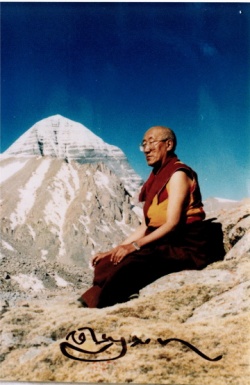The Recognition of Cessation (Nirodhasaññā)
For whom there is neither a far shore,
Nor a near shore, nor both,
Who is free from distress, without ties,
Him I call a brāhmaṇa.
— Dhammapada 385
When the recognition of dispassion is fully developed and realized, and with no self to be found, nothing to be identified with, one realizes the gnosis and vision of liberation (vimuttiñāṇadassana). This is non-referential inner peace (ajjhattasanti). This is the full recognition of cessation. AN 10.60 Girimānanda Sutta:
Now what, Ānanda, is the recognition of cessation? Here, Ānanda, a monk, gone to the wilderness, to the root of a tree, or to an empty place, discriminates thus: ‘This is peace, this is excellent, that is: the calming of all fabrications, the release of all acquisitions, the elimination of craving, cessation, nibbāna.’ This, Ānanda, is called the recognition of cessation.
This is the complete absence of agitation (calita natthi). Ud 8.4 Nibbāna Sutta:
There being no agitation, there is tranquility. There being tranquility, there is no inclination. There being no inclination, there is no coming or going. There being no coming or going, there is no passing away or arising. There being no passing away or arising, there is neither a here nor a beyond nor a between-the-two. Just this is the end of unsatisfactoriness.
This is the calming of all specific fabrication and volitional intention. MN 140 Dhātuvibhaṅga Sutta:
One does not form any specific fabrication or volitional intention towards either existence or non-existence. Not forming any specific fabrication or volitional intention towards either existence or non-existence, he does not cling to anything in this world. Not clinging, he is not excited. Unexcited, he personally attains complete nibbāna. He discerns that, ‘Birth is ended, the holy life fulfilled, done is what had to be done, there is nothing further here.’
This is the freedom of absence which is revealed through the complete recognition of selflessness. Ud 1.10 Bāhiya Sutta:
‘The seen will be merely the seen, the heard will be merely the heard, the sensed will be merely the sensed, the known will be merely the known.’ This is how you should train, Bāhiya.
When, Bāhiya, for you the seen will be merely the seen, the heard will be merely the heard, the sensed will be merely the sensed, the known will be merely the known, then Bāhiya, you will not be that. When, Bāhiya, you are not that, then Bāhiya, you will not be there. When, Bāhiya, you are not there, then Bāhiya, you will be neither here nor beyond nor between-the-two. Just this is the end of unsatisfactoriness.
This is noble liberation which is the elimination of craving and clinging. MN 106 Āneñjasappāya Sutta:
This is death-free, namely, the liberation of mind through not clinging.
This is the effortless clarity of consciousness which is non-abiding and not established (appatiṭṭha viññāṇa). SN 22.53 Upaya Sutta:
When that consciousness is not established, not increasing, not concocting, it is liberated. Being liberated, it is steady. Being steady, it is content. Being content, he is not excited. Unexcited, he personally attains complete nibbāna. He discerns that, ‘Birth is ended, the holy life fulfilled, done is what had to be done, there is nothing further here.’
There is no more seeking of any kind. There is no more personal agenda. There is no identifying with any phenomena or turning anything into a fixed reference point. There is no “here” nor “beyond” nor “between-the-two.”
The awakened mind is measureless (appamāṇacetasa), free from any sort of measuring (pamāṇa). In evocative terms, an awakened one is deep (gambhīra), boundless (appameyya), and fathomless (duppariyogāḷha). Utterly free from any reference to specifically fabricated consciousness (viññāṇasaṅkhayavimutta). “Gone” (atthaṅgata), the measureless mind is untraceable (ananuvejja) even here and now. It doesn’t abide in the head, or in the body, or anywhere else for that matter. It doesn’t have size or shape. It’s not an object or a subject.
Just as the sky is formless and non-illustrative, the measureless mind is non-illustrative and non-indicative (anidassana). This effortless clarity is unmediated by any specific fabrication or volitional intention. It is unaffected knowing: The seen is merely the seen (diṭṭhamatta). The heard is merely the heard (sutamatta). The sensed is merely the sensed (mutamatta). The known is merely the known (viññātamatta). But there is no you there. Of course, this liberating gnosis and vision can’t adequately be pointed out or indicated by words alone. It is to be individually experienced (paccatta veditabba).
The Recognition of Cessation and the Seven Factors of Awakening (Satta Bojjhaṅgā)
Sustained, dedicated practice of the recognition of cessation will gradually create the optimal conditions for the arising of all seven factors of awakening. SN 46.76 Nirodha Sutta (abridged):
Here monks, a monk develops the awakening factor of mindfulness accompanied by the recognition of cessation, dependent upon seclusion, dispassion, and cessation, resulting in letting go. He develops the awakening factor of dhamma-investigation accompanied by the recognition of cessation, dependent upon seclusion, dispassion, and cessation, resulting in letting go. He develops the awakening factor of energy accompanied by the recognition of cessation, dependent upon seclusion, dispassion, and cessation, resulting in letting go. He develops the awakening factor of joy accompanied by the recognition of cessation, dependent upon seclusion, dispassion, and cessation, resulting in letting go. He develops the awakening factor of tranquility accompanied by the recognition of cessation, dependent upon seclusion, dispassion, and cessation, resulting in letting go. He develops the awakening factor of meditative composure accompanied by the recognition of cessation, dependent upon seclusion, dispassion, and cessation, resulting in letting go. He develops the awakening factor of equanimity accompanied by the recognition of cessation, dependent upon seclusion, dispassion, and cessation, resulting in letting go.
It is in this way that the recognition of cessation is developed and cultivated so that it is of great fruit and benefit. It is in this way that the recognition of cessation is developed and cultivated so that one of two fruits is to be expected: either final gnosis in this very life or, if there is a residue of clinging, the state of nonreturning. It is in this way that the recognition of cessation is developed and cultivated so that it leads to great good. It is in this way that the recognition of cessation is developed and cultivated so that it leads to great security from bondage. It is in this way that the recognition of cessation is developed and cultivated so that it leads to a great sense of urgency. It is in this way that the recognition of cessation is developed and cultivated so that it leads to dwelling in great comfort.



